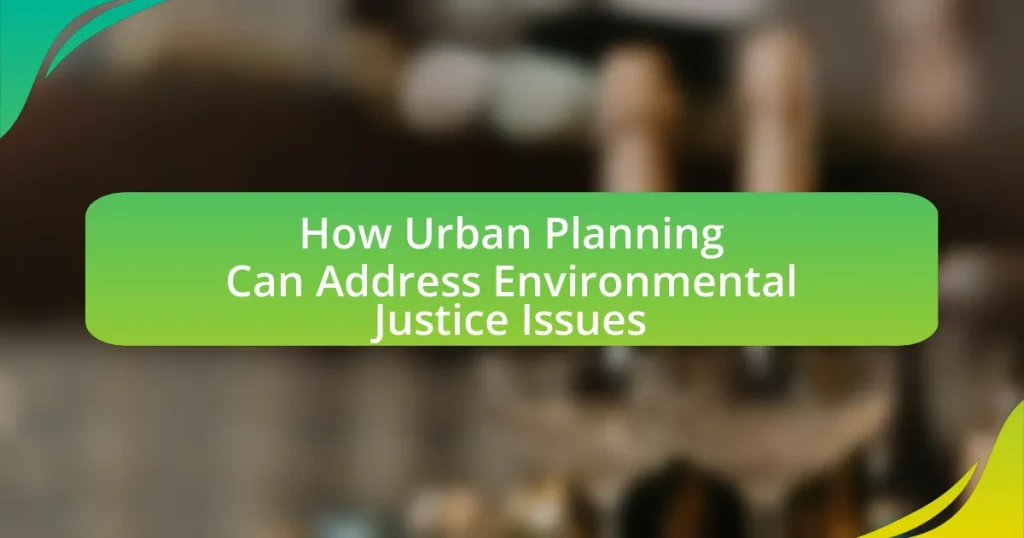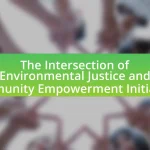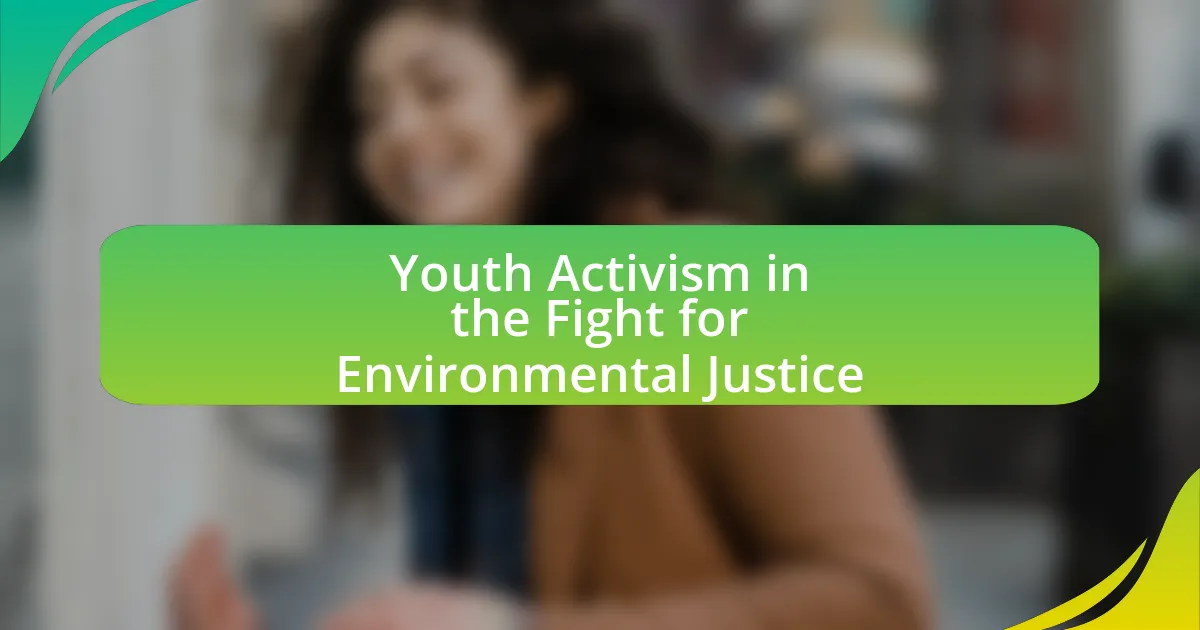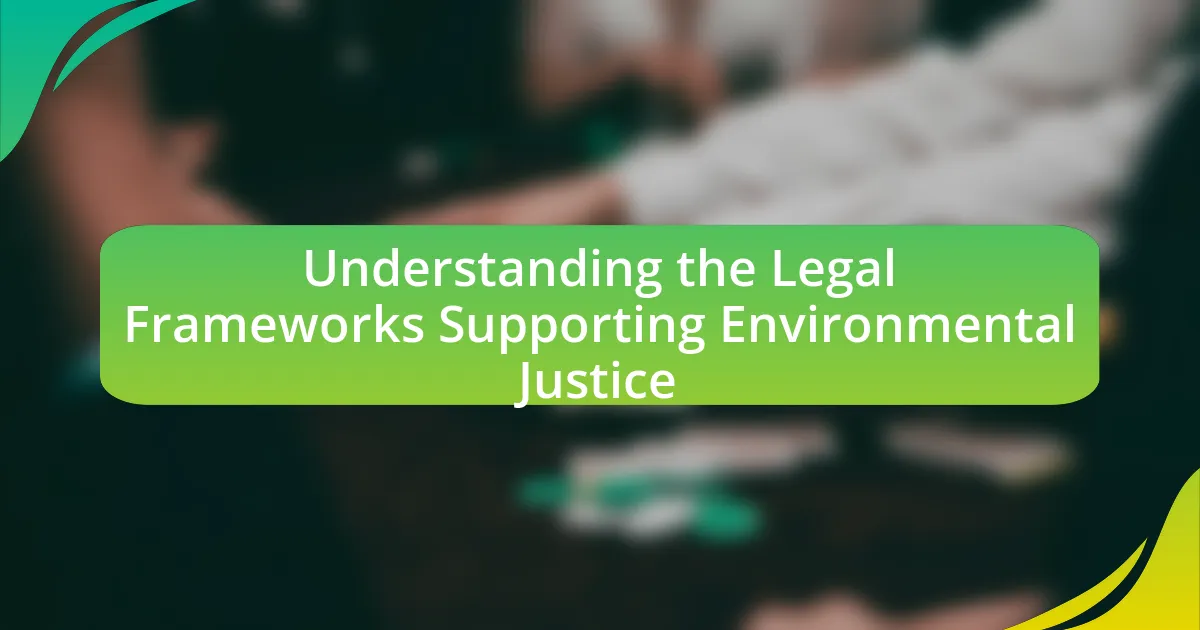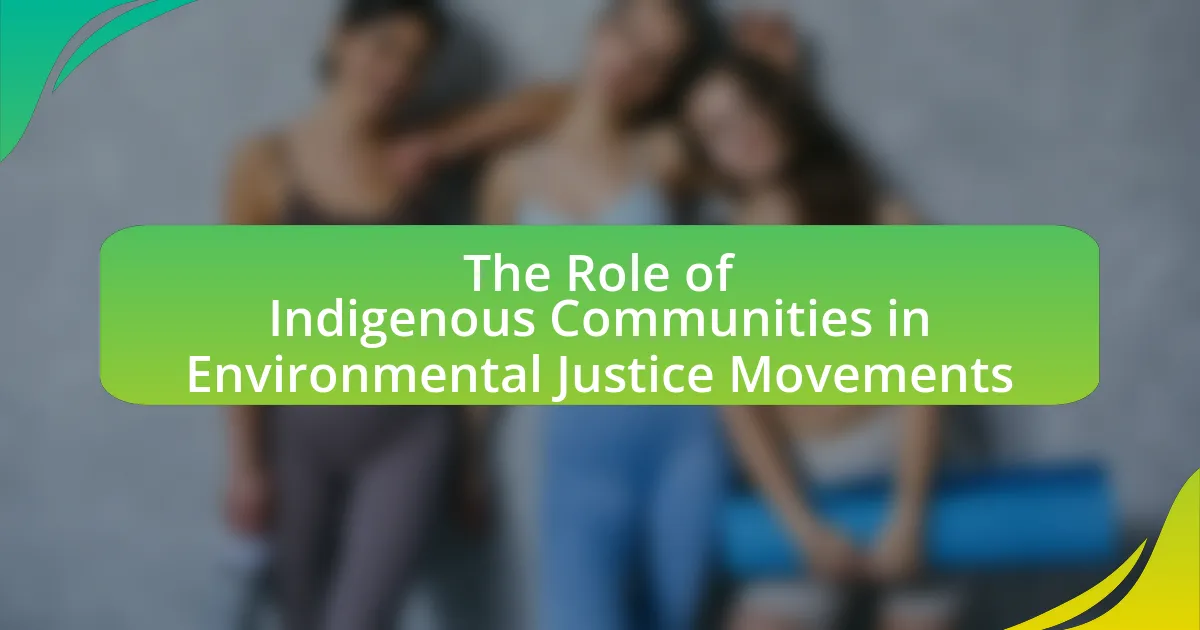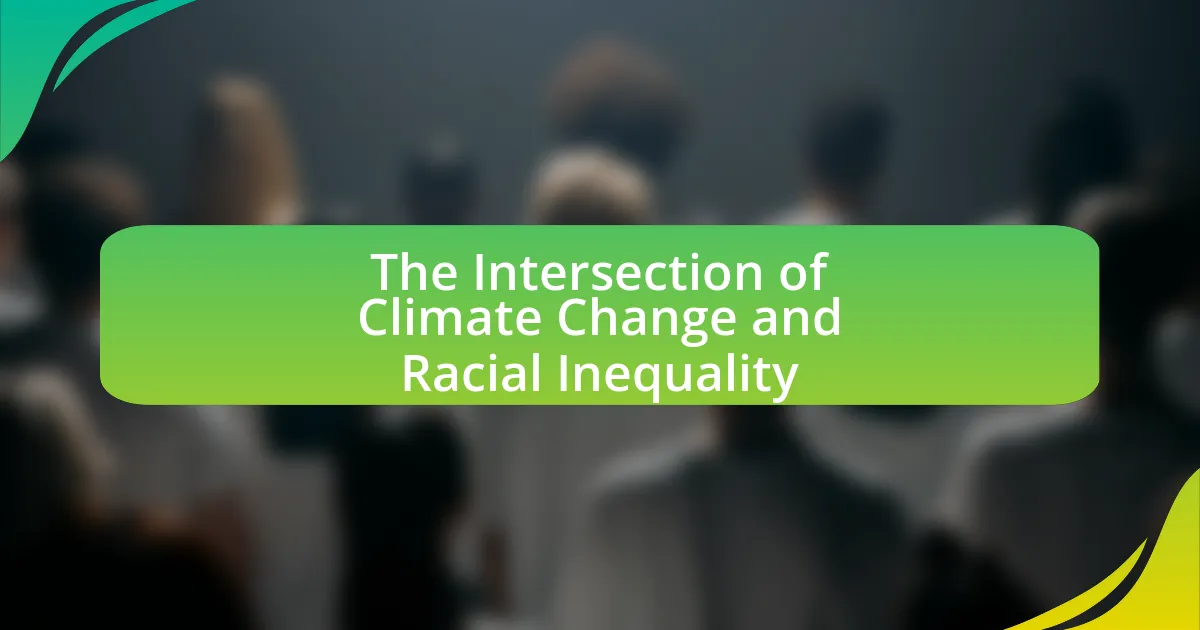Environmental Justice in Urban Planning focuses on the fair distribution of environmental benefits and burdens, particularly for marginalized communities. The article outlines how urban planning intersects with environmental justice by promoting equitable access to resources and mitigating environmental hazards. Key principles include meaningful community participation, recognition of marginalized rights, and addressing historical injustices. It emphasizes the importance of inclusive policies, community engagement, and data-driven approaches to improve public health outcomes and promote sustainability. Additionally, the article discusses the challenges urban planners face, such as systemic inequities and limited funding, while highlighting best practices and frameworks that can guide effective urban planning initiatives aimed at achieving environmental justice.
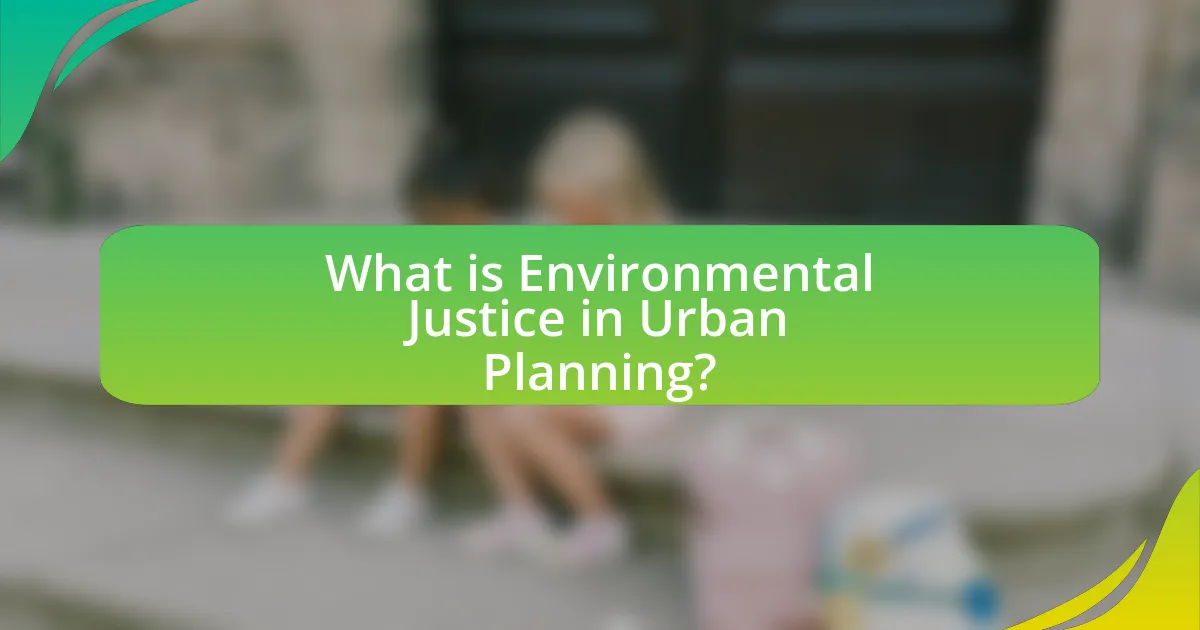
What is Environmental Justice in Urban Planning?
Environmental Justice in Urban Planning refers to the equitable distribution of environmental benefits and burdens across all communities, particularly marginalized groups. This concept emphasizes that all individuals, regardless of race, income, or social status, should have equal access to a healthy environment and should not disproportionately bear the negative impacts of environmental hazards. For instance, studies have shown that low-income neighborhoods often face higher exposure to pollution and lack access to green spaces, highlighting systemic inequalities in urban planning practices. Addressing these disparities through inclusive policies and community engagement is essential for achieving environmental justice.
How does urban planning intersect with environmental justice?
Urban planning intersects with environmental justice by ensuring equitable access to resources and mitigating environmental hazards in marginalized communities. Effective urban planning incorporates community input, prioritizes green spaces, and addresses pollution sources, which directly impacts the health and well-being of disadvantaged populations. For instance, studies show that neighborhoods with comprehensive urban planning initiatives experience reduced exposure to toxic waste and improved public health outcomes, highlighting the critical role of planning in promoting social equity and environmental sustainability.
What are the key principles of environmental justice in urban contexts?
The key principles of environmental justice in urban contexts include equitable distribution of environmental benefits and burdens, meaningful participation in decision-making processes, and the recognition of the rights of marginalized communities. Equitable distribution ensures that no group, particularly low-income or minority populations, bears a disproportionate share of environmental hazards, such as pollution or lack of green spaces. Meaningful participation emphasizes the need for affected communities to have a voice in urban planning and policy decisions that impact their environment. Recognition of rights involves acknowledging and addressing historical injustices faced by marginalized groups, ensuring they have access to clean air, water, and safe living conditions. These principles are supported by frameworks such as the U.S. Environmental Protection Agency’s commitment to integrating environmental justice into its programs and policies, which highlights the importance of addressing disparities in environmental health and access.
Why is environmental justice important for urban communities?
Environmental justice is crucial for urban communities because it ensures equitable access to a healthy environment and addresses the disproportionate impact of environmental hazards on marginalized populations. Urban areas often face higher levels of pollution, inadequate infrastructure, and limited access to green spaces, which can lead to health disparities. For instance, studies show that low-income neighborhoods and communities of color are more likely to be located near industrial sites and highways, resulting in higher exposure to toxic substances. Addressing these inequalities through urban planning can improve public health outcomes, enhance community resilience, and promote sustainable development.
What are the historical contexts of environmental justice in urban planning?
The historical contexts of environmental justice in urban planning stem from the recognition of systemic inequalities in the distribution of environmental benefits and burdens. In the 1960s and 1970s, grassroots movements emerged, particularly among marginalized communities, advocating against the disproportionate siting of hazardous waste facilities and industrial pollution in their neighborhoods. The 1982 protests in Warren County, North Carolina, against a toxic waste landfill marked a pivotal moment, leading to the first national study on environmental racism by the United States General Accounting Office in 1983, which confirmed that minority communities were more likely to be affected by environmental hazards. This awareness catalyzed the establishment of the environmental justice movement, culminating in the 1991 First National People of Color Environmental Leadership Summit, which articulated principles for equitable urban planning. These historical events underscore the ongoing struggle for equitable access to clean environments and the need for urban planning to address these injustices systematically.
How have past urban planning decisions impacted marginalized communities?
Past urban planning decisions have significantly marginalized communities by perpetuating systemic inequalities and limiting access to essential resources. For instance, redlining practices in the mid-20th century systematically denied mortgage loans to residents in predominantly Black neighborhoods, leading to disinvestment and a lack of infrastructure. According to a report by the National Community Reinvestment Coalition, neighborhoods affected by redlining have lower property values and higher poverty rates today, illustrating the long-term impact of these discriminatory policies. Additionally, urban renewal projects often displaced low-income residents without adequate compensation or relocation assistance, further exacerbating social and economic disparities. These historical decisions have created environments where marginalized communities face increased health risks, limited economic opportunities, and reduced access to quality education and services.
What lessons can be learned from historical environmental justice movements?
Historical environmental justice movements teach the importance of community engagement and the need for equitable distribution of environmental benefits and burdens. These movements, such as the 1982 protests in Warren County, North Carolina against a hazardous waste landfill, highlighted how marginalized communities often bear the brunt of environmental hazards. The success of these movements demonstrates that grassroots activism can lead to policy changes, as seen with the establishment of the U.S. Environmental Protection Agency’s Office of Environmental Justice in 1994, which was a direct response to community demands for fair treatment. Furthermore, these movements underscore the necessity of integrating social equity into urban planning processes to ensure that all communities have a voice in decisions affecting their environment.
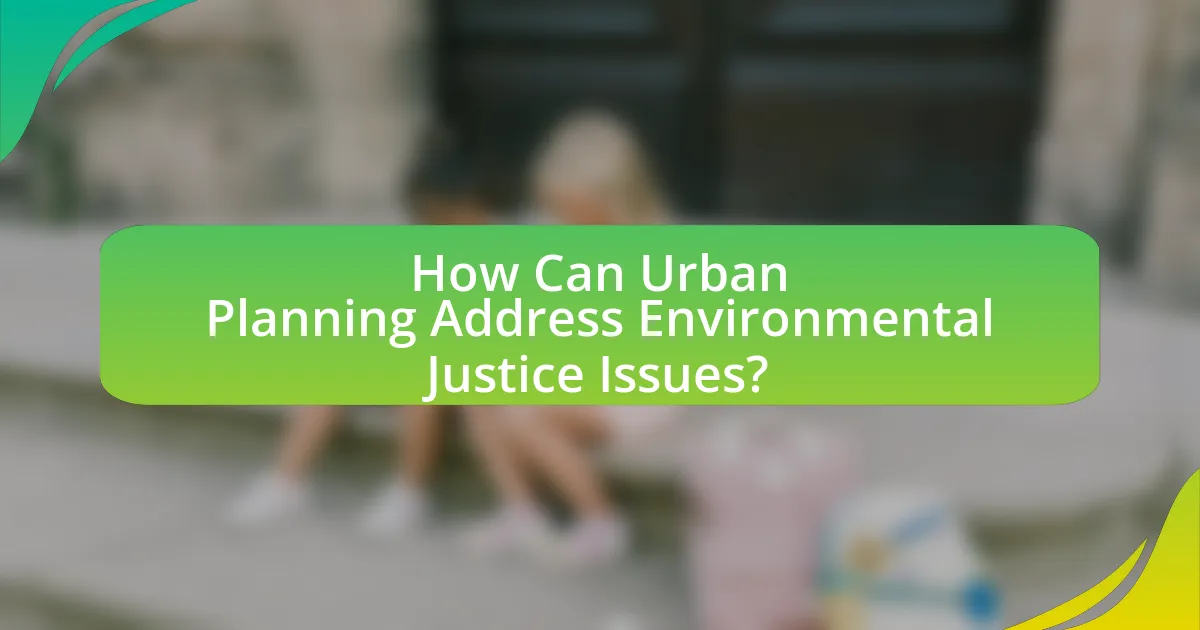
How Can Urban Planning Address Environmental Justice Issues?
Urban planning can address environmental justice issues by ensuring equitable distribution of resources and services, particularly in marginalized communities. This can be achieved through inclusive decision-making processes that actively involve affected populations, thereby identifying their specific needs and concerns. For instance, studies show that neighborhoods with higher minority populations often face greater exposure to pollution and lack access to green spaces. By implementing policies that prioritize environmental health, such as zoning regulations that limit industrial activities near residential areas, urban planners can mitigate these disparities. Additionally, investing in public transportation and affordable housing in underserved areas can enhance access to essential services, promoting social equity and environmental sustainability.
What strategies can urban planners use to promote environmental justice?
Urban planners can promote environmental justice by implementing inclusive community engagement strategies. These strategies involve actively involving marginalized communities in the planning process, ensuring their voices are heard and their needs are prioritized. Research indicates that when urban planners engage with these communities, it leads to more equitable distribution of resources and services, as evidenced by the success of participatory budgeting initiatives in cities like New York and San Francisco, which have resulted in improved infrastructure and environmental conditions in underserved neighborhoods. Additionally, urban planners can utilize data-driven assessments to identify areas disproportionately affected by environmental hazards, allowing for targeted interventions that address specific community needs.
How can community engagement enhance urban planning for environmental justice?
Community engagement enhances urban planning for environmental justice by ensuring that the voices of marginalized communities are included in decision-making processes. This inclusion leads to more equitable distribution of resources and services, as evidenced by studies showing that participatory planning can reduce disparities in environmental hazards. For instance, the 2017 report by the National Academy of Sciences highlights that community input in urban planning can lead to improved air quality and access to green spaces in underserved neighborhoods. By actively involving residents, urban planners can better identify local needs and prioritize projects that address specific environmental injustices, ultimately fostering sustainable and just urban environments.
What role does policy reform play in addressing environmental justice?
Policy reform is essential in addressing environmental justice as it establishes equitable regulations and frameworks that protect marginalized communities from environmental hazards. Effective policy reform can lead to the implementation of stricter pollution controls, equitable land use planning, and enhanced community engagement in decision-making processes. For instance, the Environmental Protection Agency’s (EPA) initiatives, such as the Environmental Justice Strategic Plan, aim to integrate environmental justice into federal programs, ensuring that vulnerable populations receive protection from disproportionate environmental risks. This approach is supported by research indicating that communities with strong policy frameworks experience improved health outcomes and reduced exposure to environmental toxins.
How can data and technology support environmental justice in urban planning?
Data and technology can support environmental justice in urban planning by providing accurate information and analytical tools that identify and address disparities in environmental impacts among different communities. Geographic Information Systems (GIS) enable planners to visualize data related to pollution sources, land use, and demographic information, allowing for targeted interventions in areas most affected by environmental hazards. For instance, a study by the Environmental Protection Agency (EPA) highlights that GIS mapping can reveal correlations between low-income neighborhoods and higher exposure to toxic waste sites, facilitating informed decision-making. Additionally, data analytics can assess the effectiveness of policies aimed at reducing environmental inequalities, ensuring that resources are allocated where they are needed most.
What types of data are essential for assessing environmental justice issues?
Essential data for assessing environmental justice issues includes demographic data, environmental exposure data, health outcome data, and socioeconomic data. Demographic data, such as race, ethnicity, and income levels, helps identify vulnerable populations. Environmental exposure data, including pollution levels and proximity to hazardous sites, reveals the environmental burdens faced by these communities. Health outcome data, which tracks disease prevalence and health disparities, provides insight into the impacts of environmental factors on public health. Socioeconomic data, encompassing employment rates and access to resources, further contextualizes the challenges faced by affected populations. Collectively, these data types enable a comprehensive analysis of environmental justice issues, facilitating targeted interventions and policy development.
How can technology facilitate better urban planning decisions?
Technology can facilitate better urban planning decisions by providing data-driven insights and predictive analytics. Geographic Information Systems (GIS) enable planners to visualize spatial data, assess land use patterns, and identify areas needing infrastructure improvements. For instance, cities like New York utilize GIS to analyze demographic data and environmental factors, allowing for targeted interventions in underserved communities. Additionally, real-time data collection through IoT devices helps monitor urban dynamics, such as traffic patterns and air quality, leading to informed decision-making. Studies show that cities employing technology in planning processes experience enhanced community engagement and more equitable resource distribution, ultimately addressing environmental justice issues effectively.
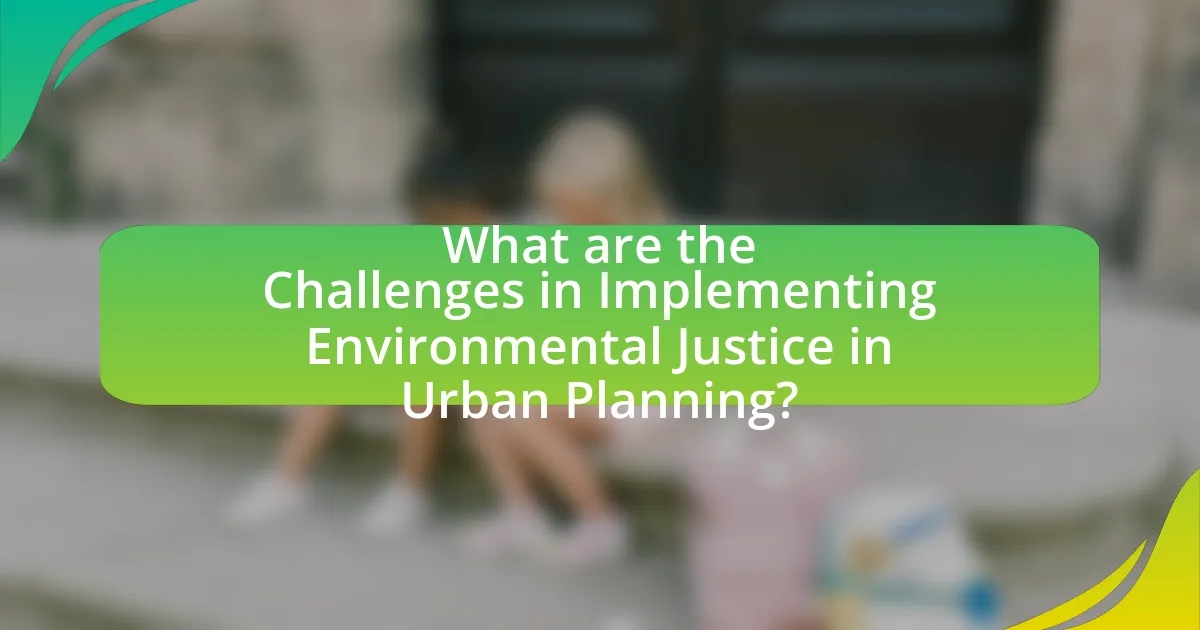
What are the Challenges in Implementing Environmental Justice in Urban Planning?
The challenges in implementing environmental justice in urban planning include systemic inequities, lack of community engagement, and insufficient data on environmental impacts. Systemic inequities often result in marginalized communities facing disproportionate environmental burdens, such as pollution and inadequate access to green spaces. Additionally, urban planners frequently encounter difficulties in effectively engaging these communities, leading to a lack of representation in decision-making processes. Furthermore, the absence of comprehensive data on environmental impacts hinders the ability to assess and address the specific needs of affected populations. These challenges are supported by studies indicating that marginalized groups are more likely to live in areas with higher pollution levels and fewer resources, highlighting the urgent need for equitable urban planning practices.
What barriers do urban planners face in addressing environmental justice?
Urban planners face several barriers in addressing environmental justice, including limited funding, regulatory constraints, and community resistance. Limited funding restricts the ability to implement comprehensive environmental justice initiatives, as many projects require significant financial resources for planning and execution. Regulatory constraints often hinder the flexibility needed to adapt plans to meet the specific needs of marginalized communities, as existing laws may not prioritize environmental equity. Additionally, community resistance can arise from a lack of trust in planners or previous negative experiences with urban development, making it challenging to engage effectively with affected populations. These barriers collectively impede the progress of urban planners in creating equitable and sustainable environments.
How do economic factors influence urban planning decisions related to environmental justice?
Economic factors significantly influence urban planning decisions related to environmental justice by determining resource allocation, investment priorities, and community development strategies. For instance, cities with limited budgets may prioritize economic growth over environmental protections, leading to the placement of polluting industries in low-income neighborhoods, which exacerbates health disparities. Studies show that areas with higher poverty rates often experience greater environmental hazards due to insufficient regulatory enforcement and lack of political power, as evidenced by the disproportionate siting of hazardous waste facilities in these communities. Furthermore, economic incentives, such as tax breaks for developers, can encourage urban planners to overlook environmental justice considerations, resulting in gentrification and displacement of marginalized populations.
What role does political will play in overcoming challenges to environmental justice?
Political will is crucial in overcoming challenges to environmental justice as it drives the implementation of policies and initiatives that address inequities. When political leaders prioritize environmental justice, they can allocate resources, enforce regulations, and engage communities effectively. For instance, the passage of the Environmental Justice Act in the United States demonstrates how political commitment can lead to legislative frameworks that protect marginalized communities from environmental hazards. Furthermore, studies show that cities with strong political will, such as San Francisco, have successfully integrated environmental justice into urban planning, resulting in improved health outcomes and equitable access to green spaces. Thus, political will serves as the foundation for meaningful action and systemic change in the pursuit of environmental justice.
How can collaboration improve outcomes for environmental justice in urban planning?
Collaboration can significantly improve outcomes for environmental justice in urban planning by integrating diverse stakeholder perspectives, which leads to more equitable decision-making. When urban planners engage with community members, advocacy groups, and local governments, they can identify specific environmental issues affecting marginalized populations, such as pollution and lack of green spaces. For instance, the 2018 report by the American Planning Association highlights that inclusive planning processes result in policies that better reflect the needs of underrepresented communities, ultimately fostering sustainable urban environments. This collaborative approach not only enhances transparency but also builds trust among stakeholders, ensuring that environmental justice is prioritized in urban development initiatives.
What partnerships are essential for successful environmental justice initiatives?
Successful environmental justice initiatives require partnerships among community organizations, government agencies, and academic institutions. Community organizations provide grassroots insights and mobilize local residents, ensuring that initiatives reflect the needs of affected populations. Government agencies offer regulatory support and resources necessary for implementation, while academic institutions contribute research and data analysis to inform policy decisions. For instance, the collaboration between the Environmental Protection Agency and local advocacy groups has led to improved air quality standards in marginalized communities, demonstrating the effectiveness of such partnerships in achieving tangible environmental outcomes.
How can cross-sector collaboration enhance urban planning efforts?
Cross-sector collaboration can enhance urban planning efforts by integrating diverse expertise and resources, leading to more comprehensive and effective solutions. For instance, partnerships between government agencies, private sector companies, and community organizations can facilitate the sharing of data and best practices, which is crucial for addressing complex urban challenges. Research shows that cities employing collaborative approaches, such as the “Collaborative Governance in Urban Planning” study by the Lincoln Institute of Land Policy, demonstrate improved stakeholder engagement and more equitable outcomes in urban development. This collaborative framework not only fosters innovation but also ensures that the voices of marginalized communities are included, thereby addressing environmental justice issues more effectively.
What are best practices for integrating environmental justice into urban planning?
Best practices for integrating environmental justice into urban planning include engaging marginalized communities in the planning process, ensuring equitable distribution of resources, and conducting thorough environmental impact assessments. Engaging marginalized communities allows for their voices and concerns to be heard, which is essential for addressing their specific needs and priorities. Research shows that inclusive planning processes lead to more equitable outcomes, as seen in the case of the Los Angeles Community Plan, which involved extensive community input and resulted in policies that better serve low-income neighborhoods. Additionally, equitable distribution of resources ensures that all communities have access to clean air, water, and green spaces, which is supported by studies indicating that neighborhoods with higher socioeconomic status often have better environmental conditions. Finally, conducting environmental impact assessments helps identify potential adverse effects on vulnerable populations, allowing planners to mitigate risks and promote sustainability.
How can urban planners ensure equitable access to green spaces?
Urban planners can ensure equitable access to green spaces by implementing inclusive zoning policies that prioritize the development of parks in underserved communities. Research indicates that neighborhoods with higher percentages of low-income residents often lack sufficient green spaces, which can lead to disparities in health and well-being. For instance, a study by the Trust for Public Land found that low-income neighborhoods in urban areas have 41% less park space compared to wealthier areas. By actively engaging with community members during the planning process and utilizing data-driven approaches to identify areas in need, urban planners can create equitable access to green spaces that serve all demographics effectively.
What frameworks can guide urban planners in addressing environmental justice?
Urban planners can utilize frameworks such as the Environmental Justice Framework, the Social Equity Framework, and the Sustainable Development Goals to address environmental justice. The Environmental Justice Framework emphasizes the fair distribution of environmental benefits and burdens, ensuring that marginalized communities are not disproportionately affected by environmental hazards. The Social Equity Framework focuses on integrating social equity into planning processes, promoting inclusive participation and equitable access to resources. The Sustainable Development Goals provide a global blueprint for addressing inequalities and fostering sustainable urban development, which includes environmental justice as a key component. These frameworks collectively guide urban planners in creating policies and practices that promote fairness and sustainability in urban environments.
